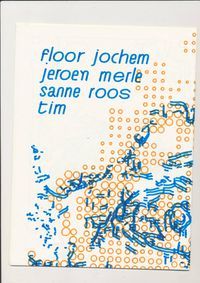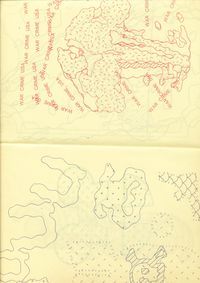Indianen + notes on texts
Indianen workshop was really nice. I liked the analog feel of the outcomes of the drawing machine. For more photos, see Sanne's[1] page. I absolutely loved the Evil Eye project, with the music from a lightsensitive microphone sort of thing. It connects to me in the way that I would really like to use music in my project.
Notes on texts:
These are my notes I made for myself, so they're probably pretty chaotic. I didn't make all notes digitally, I wrote on de texts as well. So some texts are missing here. And there are a lot of spelling mistakes.
MAKING IS CONNECTING TEXTS
week 1 (Ruskin en Morris)
making is connecting.
craft and art seperated. having ideas <-->making objects.
against secondclass status of craft
craft becomes a process of making personal self-identity, and citizenship.
need to ma:e reasons craft survived even though it's detachement from fine art.
ruskin and morris: creativity as a part of everyday life, binding force in fellowshop (community). making is connecting.
individualisme zal economische groei stimuleren.
ruskin: financial wealth which does not contribute to the stock of human happiness is no wealth at all.
to force a craftsperson to make things to fixed specification was to make them a slave.
medieval gothic style: beautiful craftmanship in the imperfections of the rudeness and savegery.
recognision of the individual role of every soul.
you must either make a tool of the creature, or a man of him. you cannot make both.
deze denkwijze: fierce denunciation of england's new industrial landscape.
marx cirtique of capitalism. dividion of labour led to alienation
alienating effect of machinework upon the worker
ruskin: industraial system steals oppurtunity to create a whole object and put mark on it.
marx; industrial system does not devie labour, it divides men: into small fragments and crumbs of life. piece of intelligence left in a man is not enough to make a pin but only the point of a pin.
two mistaken suppositions: one man's thoughts can be executed by another man's hand. manual labout is a degredation, when it is governed by intellect.
We are always in these days endeavouring to separate the two; we want one man to be always thinking, and another to be always working, and we call one a gentleman, and the other an operative; whereas the workman ought often to be thinking, and the thinker
often to be working, and both should be gentlemen, in the best sense.
individual self-expression is so vital that if a society creates supposedly rational systems (such as the capitalist division of labour) which do not allow a voice to people’s individual creativity, then the whole system rapidly becomes sick and degraded, like a tree in barren soil.
He clearly felt that a hands-on engagement with a craft was the only way to truly understand it. morris die dure elie producten maakte:
he creation of beautiful furnishings and so on is part of a process of public education, providing a model of good production methods and pioneering a return to higher standards of design’
William Morris was a man who projected a vision – a vision of great fundamental hope and optimism – through a striking number of different channels. he feared that industrial capitalism diverted people’s desires away from the natural love of nature, creativity, and fresh air, into ‘sham wants’ which it could more easily satisfy morris ook vor duurzaamheid en milieu enz. 140 jaar vooruit op zijn tijd.
For Morris, the sharing of art in a community was one of the fundamentals, part of a society’s life-
blood
Morris explains that creative work, which he more or less equates with any work worth doing, offers ‘hope’ – that key word again – in three ways
1. hope of rest. pleasure of job well done
2. hope of product. achievement of making something worthwhile.
4. hope of pleasure in the work itself. not mere habit.
So we do not have to choose between the individual or the collective: rather, a diverse community of individual voices offers a satisfying combined solution.
decorative art: apllied creativity, feeling of being excluded from fine art
vernaculat: authentic, natural voice of a community, everyday things
politics of work: crafted object become secondary to the broader ideals about the conditions in which they are made
By uniting the work process directly to the demand for a higher quality of life, they had regenerated the idea that craft was synonymous with power.
H3 DIY education nowadays only abstract humanity wouldn’t be needing the nuclear power and geoengineering if it had stuck to the caring, convivial, small-scale ecological values which Brand has always supported. zines Betsy Greer, who coined the term ‘craftivism’ (meaning – as you would expect – the confluence of craft and activism), makes the point that today it is easy to buy stuff – clothing, music, reading-matter, children’s toys, food, or whatever: cheap or expensive versions of any of these things are readily available. But, she argues, there is a resistance, a political choice, in not buying those things and choosing to make your own instead. Suggesting that people can make, fix, and repair things for themselves has much in common with sustainability and environmentalism. It also obviously connects with anti- consumerism – the rejection of the idea that the answer to all of our needs and problems can be purchased from shops In Carl Honoré’s excellent 2004 book, In Praise of Slow, which introduced the slow movement to a general audience, the author shows how the modern impetus to cram as much stuff as possible into our days has a negative effect on our well-being, and also means that we gain less pleasure, and knowledge, from the things that we do. Craft is powerful. We want to show the depth and breadth of the crafting world. Anything you want you can probably get from a person in your own community. Craft is personal. To know that something was made by hand, by someone who cares that you like it, makes that object much more enjoyable. Craft is political. We’re trying to change the world. We want everyone to rethink corporate culture and consumerism. Craft is possible. Everybody can create something! They gain pleasure from what they have done, but it is the doing it which really counts. Although this judgement may be unfair, this move away from the more obvious ‘handmade’ feel, towards a level of glossy wizardry which we find it more difficult to relate to, seemed to contribute to a general feeling that ‘creativity’ was not really taking place. what is creativity? The focus on celebrated outcomes is especially strange when we consider that Csikszentmihalyi is otherwise famous for the concept of ‘flow’. Csikszentmihalyi separates the feelings and experiences associated with creativity, from the definable hard reality of ‘actual’ high-powered creativity. Everyday creativity refers to a process which brings together at least one active human mind, and the material or digital world, in the activity of making something. The activity has not been done in this way by this person (or these people) before. The process may arouse various emotions, such as excitement and frustration, but most especially a feeling of joy. When witnessing and appreciating the output, people may sense the presence of the maker, and recognize those feelings. Creativity is something that is felt, not something that needs external expert verification. I rest my case, for now, although we’ll come back to this later.
week 2
Glenn Adamson The invention of craft craft: always there intrinsic to being human. thus industry is depersonalization. usual way of looing at it. but this book: Craft as modern invention. 1750-1850. industraiele revolution. craft was taking shape at the same time. as industries opposite. industry and cradt definine themsemself related to eachother. first undifferentiated world of making. carved into two. complex proces of human production: craft v.s. industry, freedom/alienation /tacit/explicit hand/machine traditional/progressive thinking through craft: important role craft plays in recent art history Shiner: divergence between art and craft first emerged in the renaissance and eightteneeth century was reeal seperation. but Adamson says opposition between craft and fine art is wrong, overemphasized. echt chapter analyzes an aspect of crafts differentiation as a discrete form of practise. industrial revolution. makers --> no more experience and less quality morris, ruskin, marx: craft anithetical to modernization. dit klopt niet: mid nineteenth century nog stteds veel craftsman. industralisation slow, hand and machine working together. tools extended hand skioll/ craft does not disappear. it appears within industrialism. 1851 great exhibition. widespread rethinking of skill. --
in de les: 3 main things changing. mechanisation, factory organisation (someone in control), mass-production, division of labour (not learning skill but learning part of a skill). hard for pre-industrial ways to survive. tacit knowledge: understood without saying. cultural codes for example. in craft: passed on silently in environment. tools with material, when it will break etc. learning by doing. explicit knowledge: readable. manual. craft as inferior. thinking or having a machine higher than using your hands. scale of controlling, poor workconditions etc changed, not the fact that it happened. --
Industry and handicraft. popular opinion craft - industry, differnece in character and sentimental value of product. we do not want people to think we have chep things in our homes
development tends to limit the production possibilities of handicraft and increase those of industry. this is a change we have to accept as one of the basic foundations of our work.
--
week 4
New York Times, making it
Cause achieved: philosopher goes to work and working man becomes philosopher.
movements failure by: aesthetics: promoting good taste and self-fulfillement instead of promotings things people need economics: tools too expansive for working man at home. no freedom. focus on basis inequalities. no longer radical alternative factorie life. but hobby to escape. personal computer: tool of emancipation. makers are the new hacker, defying authority. third industrial revolution: rise of makers. kickstarter.: large scale investigations unecessary. but: money to those who attract attention.
Tools for change
crafted items:
expressive, personality. everyday creativity essential to health society.
illich: making changes everything.
big scale institutions: bad. loss of personal potency.
community-bases engagement: good.
good educational system: acces to available resources any time in life, empower all who want to share what they know, furnish all who want to present an issue tot he public
loss of joyflulness in everyday experience when overplanned system
convivial tools: can be freely used. no need for qualifications.
ipad. step backward. consumption rater than production. iphone even more. fully controlled.
early home computers: open door to creativity and innovation
--
why do i make? what does artschool mean. why am i in artschool. why this artschool?

